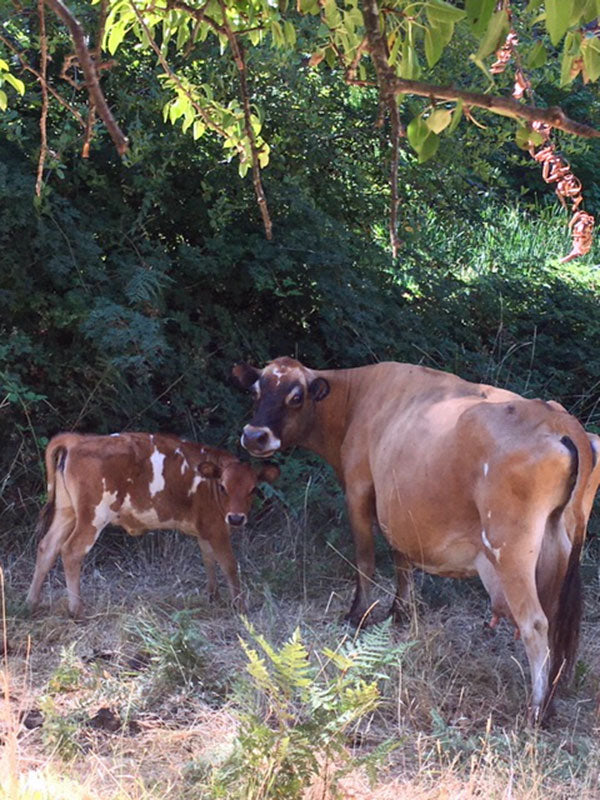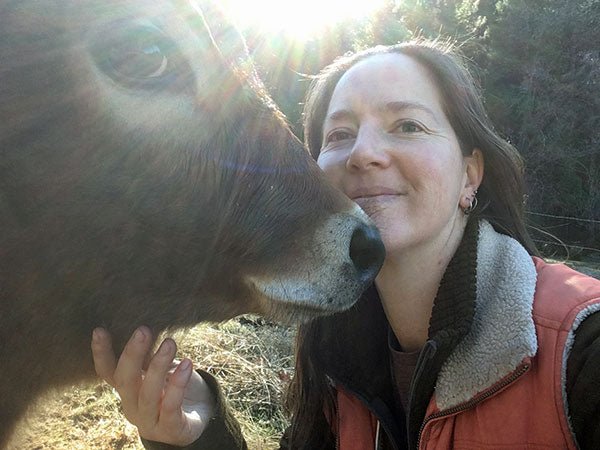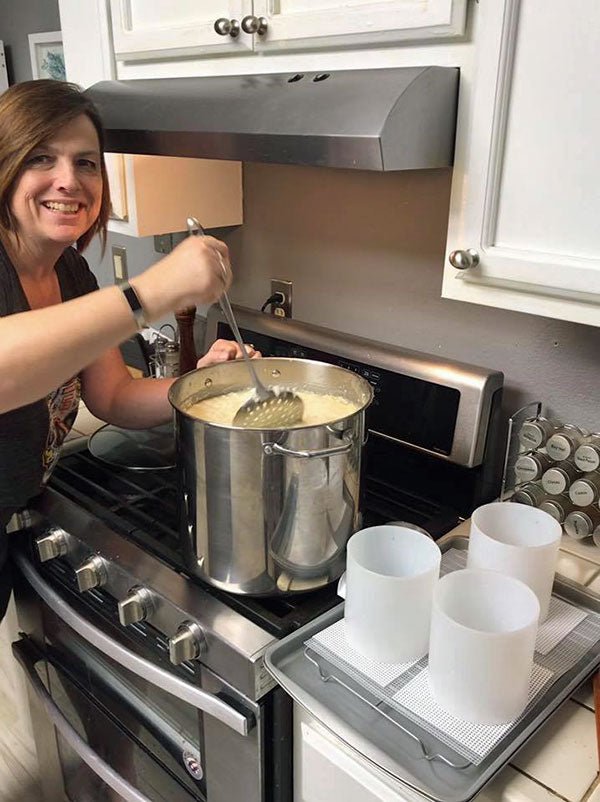
Double Raven Farm
I live on a 20 acre mountain farm above West Point, California in the lower Sierras at 3800 ft. elevation, surrounded by forest and river canyons.


I have always loved cheese and cows for as long as I can remember. I was born in Switzerland, so, I believe a love of cheese is in my blood.
My mom moved my brother and I to California when I was six, but I travel back to the homeland regularly to visit family, and through these visits I became intrigued with how cheeses are made specific to the regions and seasons.

With Lobo
I didn’t grow up in a farming or rural setting with my parents – I was born in Zürich and lived there on the outer part of the city. When we moved to California, we lived on the central coast. But both my grandmas had big gardens and fruit trees and my grandpa had horses for as long as I can remember.
My fondest memories of my grandparents include helping in the gardens, picking raspberries from hedges taller than me, making jams, feeding the chickens and helping with the horses. And their neighbors had cows, which I always wanted to visit with. All the photos of my vacation trips with my dad into the mountains feature a version of this picture:

As a young girl in Switzerland
After finishing college in Salinas with my animal health degree and veterinary technician licensing, I moved away from the coast to live with friends in the lower Sierra foothills for a year, training horses on their ranch, and getting hooked on the rural lifestyle. I packed up my truck and my horses and headed up the mountain to West Point, where I lived along the river and started dreaming of a place of my own.
About 8 years ago, 2 friends of mine were managing the community garden in West Point and got me started volunteering there. At the time, the property I lived on was forested with a limited sunny area to grow vegetables, so the garden up in town was a great place to spend time and learn more about growing vegetables. That led to learning about canning and food preserving.

With Ginger
When I moved here to the farm 4 years ago, I started a big garden and planted more fruit trees to go along with the ones already here, which are mostly apples and pears and one peach tree. Every summer and fall, I put up jars of tomatoes, spiced pears, applesauce and pickled peppers, as well as jams from the blueberries and the blackberries that grow wild along the creek, and any other fruit I can get my hands on.

A peek into my jarred goods cabinet
I still spend some of my time at the community garden, mainly in the late winter/spring to organize the seed/plant starting for our annual Mother’s Day plant sale, as well as to help with planting the main garden. The proceeds from the sale help to fund the garden’s expenses and we have a great team of volunteers growing produce for use in the twice weekly free dinners at the youth center which is operated by the local non-profit Blue Mountain Coalition for Youth and Families, of which I am a board member.
I tend an acre of organic blueberries and run the season as a U-Pick from mid June to mid August.

 I also keep a flock of chickens and share the farm with 2 horses, a Jersey milk cow and her growing calf and Lobo, an Anatolian Shepherd/Great Pyrenees guardian dog who watches the farm.
I also keep a flock of chickens and share the farm with 2 horses, a Jersey milk cow and her growing calf and Lobo, an Anatolian Shepherd/Great Pyrenees guardian dog who watches the farm.


Lobo
I’ve been working as a veterinary technician for just over 15 years, with a special interest over the last 5 years in assisting with orthopedic surgeries.
A few years ago, I got interested in the idea of keeping a cow and learning to make cheese. At the time, it was a daydream, but it grew into my reality when I brought a matronly Jersey cow, Ginger, home to the farm this last June, and she gave birth to a sweet heifer calf 2 weeks later. I’m hoping to raise Summer to be another milk cow as she is sweet and friendly.

Ginger and Lobo

Ginger and her daughter Summer
 Before getting the cows, I had been making my own yogurt with store bought milk for years, and now with Ginger’s raw milk I have begun making and experimenting with different cheeses.
Before getting the cows, I had been making my own yogurt with store bought milk for years, and now with Ginger’s raw milk I have begun making and experimenting with different cheeses.



Here is my press with my favorite mold, which is just a coffee can with the lid lip and bottom cut out and the bottom is the follower with a mason jar on top.
I started with yogurt and mozzarella and ricotta, then moved on to Farmhouse Cheddars, Feta, Monterey Jack, Camembert, Tilsiter, and Ricotta Salata.
With Ginger giving me over a gallon of milk per day (her calf nurses during the day, then I separate them overnight and milk in the morning), there’s plenty of room to experiment. I’m feeling confident in my Feta and now the Camembert, and hope to learn to make a semi-hard slicing cheese and an aged grating one also.

I cut open the Tilsiter I made 2 months ago (with Jim Wallace’s recipe) and it’s really tasty, yet mild so I’ll try to age the next one longer. This is a favorite of mine that I grew up eating, so, being able to replicate it at home is amazing!
A few of my cheeses are still aging and a few I tried recently: the Farmhouse Cheddar (tasty with an unexpectedly crumbly texture but a thick hard rind), the Monterey Jack (flavor was off, I’m guessing because the rind cracked in the drying period), and the Camemberts which are delicious and so I’ve been sharing them with friends and making them weekly!

Camembert, homemade membrillo (a sweet quince paste), and the Farmhouse Cheddar and Tilsiter in the back
I’m learning from Home Cheese Making and David Asher’s The Art of Natural Cheesemaking, which uses kefir in place of starter cultures – especially tasty with the feta. I apply the learn-as-I-go attitude with most projects (growing blueberries, gardening, livestock) so it seemed natural to get some cheese making supplies and give it a go. It’s definitely not foolproof and I would love to find some local instruction, but so far I haven’t found any classes within the greater Sacramento area.
Right now, I’m trying to think up a way to keep the humidity at an even point in my cheese cave fridge. The Camemberts are easy to keep under a plastic cover for humidity control, but so far my aged cheeses are drying out and either cracking or getting a really hard thick rind on them.

My cheese fridge – 2 batches of Camembert on the bottom, then a Tilsiter, and on top is the Monterey Jack and a Farmhouse Cheddar.
I’m excited to start tasting some of my aged cheeses and to continue this journey! Thanks for this opportunity to get my story out there!















































































































































